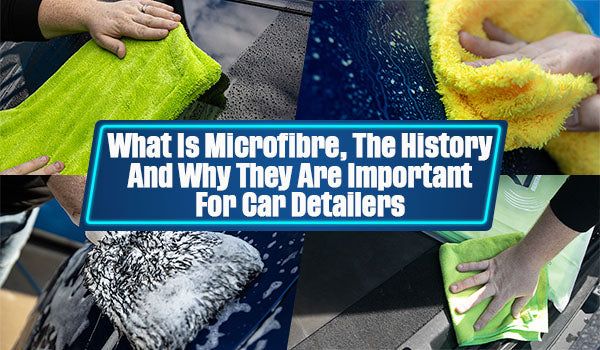My Cart
Your Cart is Currently Empty
NEXT WORKING DAY DELIVERY - ORDER BEFORE 2.30PM

Microfibres were first developed in the 1950s as a new type of synthetic fibre. However, it wasn't until the 1970s that microfibres started to gain attention in the textile industry. The first microfibre fabrics were made from polyester and nylon, and they quickly gained a reputation for being soft, lightweight, and durable. They were also found to have superior moisture-wicking properties, making them ideal for use in athletic wear and other performance clothing.
In the 1980s, microfibre technology continued to evolve, and new manufacturing techniques were developed that allowed for even finer fibres to be produced. These new microfibres were thinner than human hair and were able to trap and hold onto dirt and dust more effectively than traditional fabrics.
Microfibre cloths and cleaning products started to become popular in the 1990s as people began to realise their superior cleaning ability. Unlike traditional cleaning cloths, microfibre cloths could pick up and hold onto dirt and dust, rather than just pushing it around on the surface.
Today, microfibre technology has continued to evolve, and new blends of microfibres have been developed that offer even greater cleaning ability and durability. Microfibre fabrics are now used in a wide range of products, including cleaning cloths, vehicles, athletic wear, bedding, and upholstery.
In conclusion, while microfibres have been around since the 1950s, it wasn't until the 1970s and 1980s that they started to gain attention in the textile/vehicle industry. Today, microfibre technology has continued to evolve, and microfibre fabrics are used in a wide range of products due to their superior cleaning ability, durability, and moisture-wicking properties.
1. Superior cleaning ability: The tiny fibres in microfibre cloths can pick up and hold onto dirt and dust much more effectively than traditional cleaning cloths. This makes them ideal for cleaning surfaces such as painted vehicles, countertops, mirrors, and windows.
2. Environmentally friendly: Microfibre cloths are reusable and can be washed hundreds of times, reducing the need for disposable cleaning products. Additionally, they require less water and cleaning solution than traditional cloths, making them a more sustainable option.
3. Versatile: Microfibre cloths can be used for a wide range of cleaning tasks, from dusting and wiping down surfaces to cleaning up spills and stains. They can also be used for dry or wet cleaning.
4. Non-abrasive: Unlike traditional cleaning cloths, microfibre cloths are less-abrasive and won't scratch delicate surfaces such as glass or stainless steel but can induce marring/swirls if used with pressure.
GSM stands for grams per square metre and is a measure of the weight and density of the fabric. In the context of microfibre cloths, GSM refers to the amount of microfibre material used per square metre of fabric.
Microfibre cloths come in a range of GSM values, typically ranging from around 250 GSM to 1500 GSM or more. A higher GSM value generally indicates a thicker and more densely woven microfibre cloth, which can offer better cleaning performance and durability. However, the optimal GSM value for a microfibre cloth can depend on the intended use. For example, a thinner and lighter microfibre cloth may be more suitable for dusting or cleaning glass, while a thicker and heavier cloth may be better for cleaning floors or other heavy-duty tasks. Within the car cleaning industry, we tend to use 300-500GSM with Quick Detailers like Nitro Quick Detailer and Sealants and 1000+ on drying towels or in the case of a Duel Triple Twisted Loop Drying towel, 14000gsm.
It's also worth noting that the GSM value is just one factor to consider when choosing a microfibre cloth. The quality of the microfibre material, the weave pattern, and the overall construction of the cloth can all affect its cleaning ability and durability.
In summary, GSM is a measure of the weight and density of the fabric and is commonly used in the context of microfibre cloths to indicate the amount of microfibre material used per square metre. While a higher GSM value can indicate a thicker and more durable cloth, the optimal GSM value can depend on the intended use and other factors.
1. Use dry for applying sealants and QDs: Microfibre cloths are great for dusting as the fibres can trap dust particles and hold onto them. Simply use a dry microfibre cloth to wipe down surfaces and pick up any dust or dirt.
2. Use damp for cleaning: For more stubborn stains or spills, dampen a microfibre cloth with water and use it to wipe down the affected area. microfibre cloths can also be used with a cleaning solution but be sure to follow the manufacturer's instructions and avoid using harsh chemicals.
3. Wash regularly: To get the most out of your microfibre cloths, it's important to wash them regularly or after use. Use a gentle detergent (non-bio) or a dedicated wash media such as Laundry Microfibre Wash Detergent and avoid using fabric softener, as this can clog the fibres and reduce their cleaning ability and or ability to absorb liquid. Always air dry the cloths or tumble dry them on a low heat setting. Drying the cloths and towels with heat can also damage the fibres.
In conclusion, microfibre cloths are an excellent choice for anyone looking for an effective and sustainable cleaning solution for their vehicle. With their superior cleaning ability, versatility, and environmental benefits, they have become a staple product in any cleaning arsenal.
There are many different types of Micro fibres, Pearl Weave, Split Weave, Flat Weave, Chenille, Waffle Weave, Twisted Loops and Plush, to name a few.
Go check out the fantastic Microfibre range from Duel.
We would like to take this opportunity to thank Steve McMahon for writing this informative article and please take a minute to go and follow him on instagram and facebook, Geeky Detail Reviews & The Car Boutique